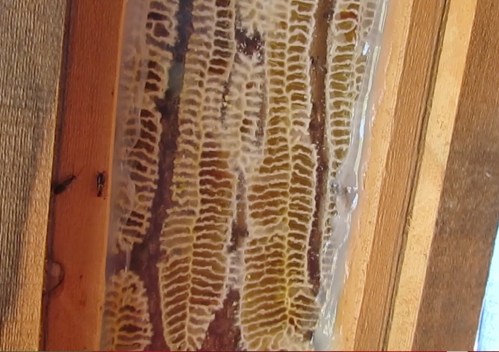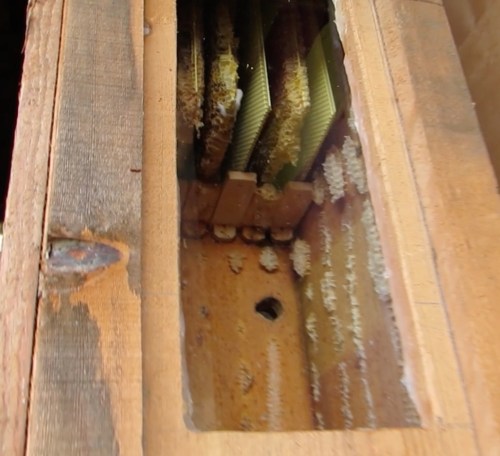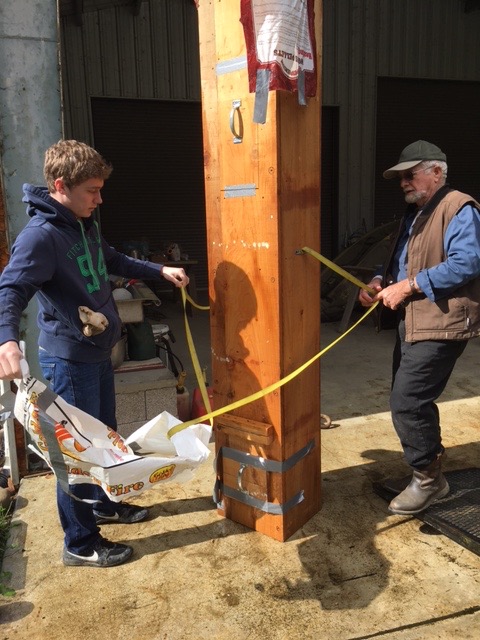
#3 Log Hive is still occupied after 4 years.
Number 4 Tall Hive in it’s glory days last year.

After not finding any decent logs, Hal bought some rough-cut red cedar and built this ‘log’ hive last year. This picture was taken after a swarm of bees decided on their own to move into it in May 2015.

This was in July last year. The bees built natural comb about 3.5 feet long. The entrance to Hal’s observation hive is seen on the left.

Looking through the observation window, you can see beautiful natural comb.

Hal’s observation hive was full of natural comb and bees at that time too.
So you can imagine the heartbreak of realizing the #4 hive was a goner in late September. Hal took it down and opened it up…

We took the lid off #4 after we suspected it had died out. We were impressed at the length of the comb…but unimpressed at the lack of honey. It’s possible it was cleaned out by yellow jackets last summer because we could see a pile of cappings on the hive floor.
Not to be discouraged, Hal cleaned out #4 hive and tacked on some screens.

Feb. 9, 2016…screened off the ventilation holes to keep the yellow-jackets out…

…added some honey comb and new foundation, and re-homed it.

Late February 2016…Number 4 hive on location, braced against a tree for support, baited for more bees and in plenty of time for a nice swarm of bees to repopulate it.

Feb. 9, 2016…Log hive #5, showing the observation window and cover. This hive is approximately 2″ thick (5 cm) and 8′ (2.4m) tall. A sheet of plexi-glass is mounted inner-most of the window which starts at just about the end of the foundation. I always admire Hal’s craftsmanship.

Another look at #5 log hive, awaiting its move to the new location. This photo shows the square access ‘window’ to a screen towards the bottom of the hive. Above the square is a slide-out mite board. Also pictured is the cover to the access hole. Hal explains how it works in the video.

Grandson Brodie Parrish helps Hal take off delivery straps.

Hive #5 just about ready for an April swarm. Hal is sharing his bee expertise with the younger generation.

Patti, a young 80 year-old, built this fountain and pond completely by herself.
Patti’s Poem
“Hal is Hooked on Bees”
Oregon’s spring will be here before long
Birds will twitter their unending song
Trees, shrubs, flowers will come alive
Orchards and gardens soon will thrive
But, without the honey bees we are lost
Salubrious summer sun is tossed
On our gardens where we toil and till
Hoping bees come with a working will
Years ago we had plenty of Bees so true
But when the old century turned into new
Along came CCD, bee colonies collapsed
Trumpets began playing dead Bee Taps
Bee deaths plagued my husband dear
A calm bee keeper for many a year
Now we tell how he learned to care
To save Bees so all the world can share
In 1995 our friend thought of us to show
How Honey Bees helped our garden grow
A lush home garden must have bees near
Pollination! Don’t even consider sting fear
Two bee hives placed near our front door
Our friend kept stacking up supers galore
With the boxed frames beeswax filled
A new swarm brought in the honey swill
Every week supers were piled on high
Hives grew seven feet nearer the blue sky
We saw pollen carried into the new hive
On every bee’s legs & the colony thrived
Our friend baited Hal, he just had to say
Bees dance! To show where to work today
Scouts fly to find tree homes that are okay
Then they dance to show swarms the way
Well, Hal was hooked, he had to try
Do the bees really dance, as well as fly?
Yes, said our friend as he harvested honey
And that liquid gold lasts longer ‘n money
Honey! The only food that never spoils
Made by the Honey Bees unending toils
On Crest Acres the World Record was set
Two hives gave more than anyone bet
Honey, six hundred and thirty pounds
Hard to believe, when it was so near town
That honey was soon taken with care
It was like St. Nicholas had visited there
Our friend put honey in a clear pint jar
Sent to the County Fair, to the Judge’s bar
Clear as glass, our honey took first prize
Friend gives pint to Hal, enticement-wise
Seven supers of honey were taken away
But the winter-ready hive has honey today
The Queen rests, as her ladies slip along
Used-up drones no longer sing their song
Wind rakes and the rains soak forest trees
The Queen is surrounded by her lady bees
They work the winter cleaning wax cells
Waiting ‘til warmth rings the Queen’s bell
Lady bees search out dry days in winter
Like to leave their warm, comfy center
They’re full, eating plenty of pollen soup
On good days, they fly out to take a poop
Early spring pulls the Queen’s trigger
She lays 2500 rice-sized eggs – not bigger
Every day at each cell she carefully stops
Each of the six-sided cells gets one drop
Right at ninety degrees the brood is kept
While the warm neat hive is cleanly swept
As the nurse bees crawl quietly about
In 21 days little bees chew their way out
Coquille Valley’s growth is super awesome
Good and plenty spring/summer blossoms
The Queen works, but may get moody too
Gather her team and swarm into the blue!
Patti Strain, January 2012
Updated: March 15, 2016
Patti also wrote The Story of Hal’s Bee Trees

Hal and Patti Strain

This is so great, I love how Hal keeps going and coming up with new improvements. Thanks for the excellent documentation!
Hal and Patti are always busy. Patti has written quite a few books on the history of her family. She’s now working on World War II and welcomes any stories people might have of that era.
Hal works in his wood shop. He always has a project going. When he’s not improving his beehives, he’s working on some other project. You might notice the background of the 10th photo. I think he mentioned he was working on project for his daughter.
What amazing hives, stunning to see all that natural comb inside. What is the reason for making them quite so tall though, it seems like the bees only need half the space as they’ve left the rest empty?
Hal and Patti live inland where it’s warmer. The bees have more time to work and build up faster. That tall hive was about 2/3’s full of natural comb…with no interruptions, like a hollow tree, the most natural kind of beehive. If it hadn’t been attacked by the yellow jackets, that hive would have been filled with honey. Hal doesn’t rob the honey, so those bees would have been in great shape for the winter…and then some.
Some serious woodworking, very impressive.
Hal is a great woodworker. Whenever I see the work he’s done, I try to emulate it…let’s just say I’m a better printer than I am a woodworker. 🙂
🙂
Such long honey comb! I share Patti’s sentiments about bees in the garden. I can’t imagine a garden without bees. Amelia
This year we’re growing (starting from seeds) even more bee-loving flowers. Every year we try to expand the nectar producing flowers, but with only one hive so far, we don’t see that many honeybees. I’ve got to get a few swarms in order to make the most of our ‘bee garden.’ In the past few years I’ve just taken the presence of bees for granted, I’m afraid.
I think the wild bees need our help every bit as much as the honeybees so nectar producing flowers satisfy all of us. Pollen is very important early in the season too. I suppose in Oregon you are not short of lots of trees that produce pollen early in the season. Amelia
Wild bees sometimes are MORE efficient pollinators than honeybees. We are super excited this year because…well, after successfully foot dragging for a number of years my wife has convinced me to get a deer fence. The deer fence will enable us to grow all kinds of flowers that in the past would grow until they blossomed and the lovely deer would chomp them off. Arrrrgh!
That is really going to make a big change in what you can try in the garden. We have Roe deer around us but they seem timid and stay clear of the garden, thank goodness!
Hi,
THANK YOU for taking such clear photos and for shooting such an informative video about the log hive (#4). The design is great – and will prevent me from rolling around a heavy tree log in attempts to hollow it out! One question…
Is there any modification that you can see to your Log Hive #4 that would allow you to harvest some honey? Perhaps only the lower part of the comb?
In the log hive as you have it, the bees will build comb on the “4th wall” (wall with the observation window) but … what could you do to allow yourself entrance – even just into part of the hive – without tearing out the hive when you open the door of the 4th wall?
Interested in hearing your ideas — you’ve been playing with log hives before and I have not!,
Myles